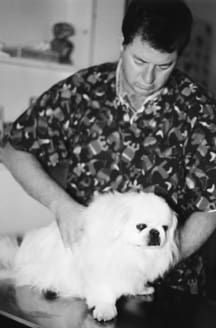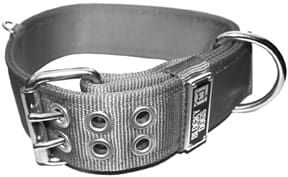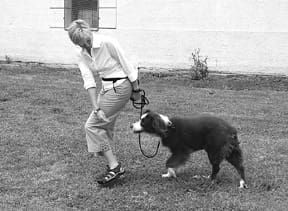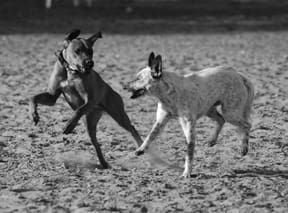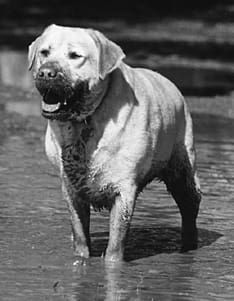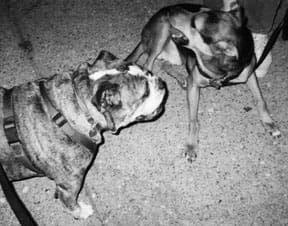The bones that dog owners are most familiar with are the ones they buy for their dogs to chew; ideally, these are moist, fresh (or frozen) cattle bones, still sporting tissues that dogs can tear and gnaw off and nutritious marrow to extract. Posing a great deal more risk to a dog’s teeth are the dead, nearly fossilized bones sold in many pet supply stores.
The bones inside the living dog barely resemble the dry, brittle bones sold as recreational chews. Rather, living bone is a dynamic, vibrant organ that is in a perpetual state of flux, constantly generating and dying, accumulating and being worn away.

Living bones perform a multitude of functions. They provide scaffolding for softer tissues and offer protection to inner organs; they are the levers that create movement around joints; their inner core produces all the blood that circulates throughout the body; and, as other body cells circulate through it, the skeleton’s scaffold creates a permanent communication center for kinesthetic, neurologic, and immunologic information to be processed. The skeleton as a whole is truly a multi-tasking marvel.
Physiology and function
Bone is perfectly composed to perform its most primary function: to provide a sturdy base that allows for movement and protects and supports the body’s softer tissues. From a chemist’s viewpoint, bone could be seen as an ideal conglomerate of several kinds of materials that each have a specialized function. The resultant composite that we call bone is a substance that is much like fiberglass: firm without being too brittle, flexible and somewhat rubbery without being too bendable, firmly tied together with a strong interweave of fibrous material.
The hard part of bone is mineral – mostly salts of calcium and phosphorous. Bone’s mineral deposits ultimately align themselves so they are positioned to withstand the normal stresses placed on the dog’s moving limbs and other body parts. Healthy bones carry an extra factor of strength – enough to withstand the extra stresses of the running, jumping, and turning of an active dog. Note that this reserve of weight-bearing capacity occurs in healthy bones, and is enhanced through exercise along with proper nutrition.
For optimal performance, bone needs to be heavy or dense enough to offer protection and to withstand the loads imposed by the dog, including excessive loads, yet light enough that the dog can still move around with ease. One way this is accomplished is with structures that are nearly hollow, with material of much lesser density in the middle, offering maximal strength with minimal weight.
The mineral part of bone is mixed within a matrix of collagen, a relatively rubbery, connective tissue mostly made up of proteins. Collagen is also present in tendons and skin, and it forms the cartilage that protects bone ends as they rotate against each other. Collagen fibers are interconnected throughout the mineral portions of bone via fibrous connecting links, and the collagen and fibrous tissues are aligned in a fashion that allows bones to withstand stresses applied from all directions – an accomplishment that would fascinate a structural engineer.
Veterinary practitioners, however, are more concerned with how to maintain healthy bones, prevent abnormal bone formation, and heal bones that are diseased or fractured. We rely on the basics of bone physiology to help us support these tasks.
Bone growth
If we look at living bone tissue under the microscope, we see mineralized tissue, a proteinaceous matrix, and several types of bone cells. Interestingly, in a healthy bone we’ll see one type of cell that is manufacturing mineralized tissue (osteoblasts) and another cell type that is eating or eroding away mineral (osteoclasts); often, the cells are almost side by side. (A third type of bone cell, the osteocyte, seems to be just sitting in the midst of bone matrix; we’ll see what it is doing later.)
At first glance this simultaneous growth and “decay” doesn’t make sense at all, but it becomes more comprehensible when we understand the dynamics of bone formation.
Bones constantly reorganize in response to the physical stresses placed on them and to the mineral needs of the body. (For more on the latter, see the sections on bone diseases caused by metabolic and nutritional problems, below.)
As a bone is subjected to the stress of bearing weight, the osteoblasts are stimulated to produce additional mineral mass to withstand the additional stress. However, if this went on indefinitely, the bone could grow to tree trunk size, and the dog would no longer be able to walk. So, along with the bone formation (mineralization), there is concurrent de-mineralization somewhere in the bone where the stresses are not as great. The result is a constant dynamic realigning of the bone, with more mineralized mass accumulating where it is needed. Note that this process is ongoing and normal throughout the life of the dog.
Bone lengthening in the growing dog is another almost mystical event. During the time frame when a puppy’s long bones are growing in length, the ends of the bones must maintain a cartilaginous and lubricated surface so they can move against one another through the joint. This means that the bone growth cannot occur at the very ends of the bones. Instead, a puppy’s bones grow outward from the epiphyses, near the ends of the bones. The new boney tissue actually emanates from a line of cartilaginous tissue called the physis or “growth plate,” that runs across the bone. It is evident in radiographs as an area of non-mineralized tissue within the bone.
When a dog (or other mammal) reaches maturity, the growth plates “close” or become mineralized, precluding further growth along the length of the bone. Damage to a growth plate during the dog’s growing phase (an epiphyseal fracture, for example, or the repeated and excessive compression of the growth plates caused by allowing too-young agility candidates to jump too much) can lead to a permanent cessation of long bone growth, with resultant shortening of the affected limb.
At the same time a pup’s bone is growing in length, it is adding more mass to support the pup’s gowing weight. The obvious way to do this would be to add mineralized tissue to the outside of the bone, but if too much bone were deposited, the bone could become enormous. So, once again, the bone balances the mineral that is laid along the outside of the bone with bone resorption along the bone’s inner core.
While this entire process is elegant in its conception, there are times when it goes awry. Prime examples of bone formation gone bad occur when there is abnormal joint movement, as when the dog suffers hip dysplasia or as a result of decreased mobility of a vertebrae. With abnormal joint movement, the bones surrounding the joint try to compensate with excess bone growth (exostosis) that we refer to as osteoarthritis. (We’ll discuss osteoarthritis and other diseases of joints in much more detail in a future installment of the Tour of the Dog).
Boney growths in or surrounding the joint often produce pain and result in a lack of mobility in the joint. If they are allowed to continue, these growths may ultimately totally fuse the joint.
The periosteum, a specialized connective tissue that covers all bones, is highly vascularized and has the ability to form bone. Irritation to the periosteum is painful, and can produce excess bone growth.
Other roles
Bone also produces blood cells. All the blood cells in the adult animal are produced in the bone marrow, located in the relatively hollow core of the bone.
Further, bone plays an important coordinating role in the body. Immune information is processed in the bone as blood circulates through the boney tissues – interesting, given that bone is one of the longest-living tissues in the body. In addition, the skeleton is a primary source (primarily through nerve sensors located in the joints) for providing kinesthetic information to the whole body, informing the animal of its posture at all times.
Unfortunately, boney tissues also provide an ideal microenvironment for trapping cancerous cells that are circulating through the body, and the growth of those tumor cells may continue within the bone.
And finally, we know that those osteocytes that we once thought were simply inert cells that had been isolated within the bone’s calcium matrix are actually intimately connected to one another throughout the entire structure of the skeleton. This interconnection of nervous and immunologic input within long-lived skeletal tissues may some day prove to be one of the most important sites for giving and receiving whole-body communications.
Fractures and fracture repair
Fractures are probably the most common bone “disease” in dogs. Any bone of the body may be involved, usually as a result of a traumatic incident (however, see metabolic diseases, below, for other causes of bone fractures).
When a bone is fractured, the surrounding blood vessels are also usually broken, and blood hemorrhages into the area and forms a clot. This clot is converted into a fibrous mass, and new blood vessels begin to interlace into this mass. As the clot continues to harden, it forms a structure (called a callus) that begins to hold the ends of the bone with reasonable firmness.
After about two weeks the adjacent periosteum produces fibroblasts that begin to develop osteoblastic characteristics. As more and more calcium salts are deposited, the tissue becomes more rigid osteoid or bone. This early bone (cancellous or spongy bone) is not yet organized into fully mature bone, and its relative softness may take months or even years to become fully organized, strong bone.
While most bones will ultimately heal on their own, they will heal much faster (and with less pain for the dog) if some form of stabilization is provided. Fractures in youngsters tend to heal much faster than in older dogs.
The prognosis is guarded, however, if the immature dog’s epiphysis is involved in the fracture. Healing may be prolonged, and/or premature closure of the growth plate – and resultant cessation of the growth of the affected bone – may result.
Infectious diseases
Infections, referred to as osteomyelitis, are a common cause of inflammatory disease of the canine’s bones. Typically a penetrating wound would be involved as the source of infection, or infections may occur following fractures or during surgical fracture repair.
Symptoms include pain (sometimes with refusal to bear weight on the affected limb), local swelling, and fever. As the disease progresses, draining tracts may occur. X-rays will reveal areas of bone lysis (areas where bone mass has been dissolved). If the condition continues, there may be boney growth surrounding the infection and areas where bone tissue has died.
Osteomyelitis may be instigated by many types of bacteria (the most common one being Staphylococcus aureus), but about half of all infections involve more than one species of bacteria. Treatment consists of antibiotic therapy, with culture and sensitivity often needed to accurately appraise the bacteria to match it to the appropriate antibiotic. If the case has become chronic, surgery may be needed to remove extra bone growth and any dead bone tissue resulting from the infection.
Note that there are also several mycotic (fungal) organisms that infect bone tissue, and these often require specialized diagnostic procedures to ferret out as well as specific medications to treat. The more common examples include:
• Coccidioidomycosis – A respiratory disease that occurs primarily in the Southwest U.S.; it also may infect bones.
• Histoplasmosis – A disease of the gastrointestinal tract that may extend to the skeletal system.
• Blastomycosis – A skin or generalized infection that may also involve bone.
• Actinomycosis – The Actinomyces organism is a normal inhabitant of the mouth of most dogs (and cats); penetrating wounds of the mouth may result in infections of surrounding bones.
• Nocardiosis – A respiratory infection that may spread to the skeletal system.
• Aspergillosis – An infection of the nasal passages, noticed as a chronic nasal discharge. Bone tissues may also be involved. Metabolic bone disease
There are a number of diseases that can loosely be categorized as “metabolic” in origin. The primary examples include the following:
• Renal hyperparathyroidism – This tongue-twisting disease is caused by chronic kidney disease, which results in an excessive rate of parathyroid hormone (PTH) secretion, which in turn causes a softening of the affected bones. Although the loss of hard boney structure is generalized throughout the body, the most noticeable area of involvement is the jaw, and the bone loss here is referred to as “rubber jaw.”
• Nutritional hyperparathyroidism has the same end result (rubber jaw), but in this case the causative agent is an improperly balanced diet – often from an all-meat diet fed to a growing animal. All-meat diets are too high in phosphorous and/or deficient in calcium, creating low blood calcium levels. The body attempts to correct this by demineralizing the skeleton, mining it for its calcium. This can result in bones that are vulnerable to fracture and deformity.

• Primary hyperparathyroidism is a rare disease, typically seen in the older dog. Its cause is a functional lesion of the parathyroid gland that results in a higher than normal level of PTH.
• Hyperadrenocorticism – Can be a result of Cushing’s disease or from prolonged and/or excessive administration of glucocorticoids. This can have several adverse actions on the maintenance of healthy bone. It can inhibit absorption of calcium from the gut (via an antagonistic effect on vitamin D), increase urinary excretion of calcium, and/or decrease proliferation and differentiation of fibroblasts and osteoclasts, thus affecting the elaboration of collagen and bone matrix. It can also have a catabolic (tissue destroying) effect on proteins, resulting in abnormal production of the bone matrix. The osteoporosis associated with this disease is usually prominent in the spine and long bones.
• Osteoporosis, a human disease that often affects postmenopausal women, is a disease that has not yet been reported in dogs, at least not in the same, hormonally-related form that is seen in older humans. There are, however, several diseases and toxicities that may result in thinning of dog bones (secondary osteoporosis), including: drug intoxications; the hyperparathyroidism and Cushing’s diseases mentioned above; hyperthyroidism ( a disease more common in cats than in dogs); hepatic toxicities; disuse due to immobilization of the limb; multiple myeloma; cysts; and tumors.
With any of these osteoporotic diseases in dogs (or humans) the telltale clinical sign is a fracture of one or more of the long bones or vertebrae. The prognosis for any of the osteoporotic diseases depends on the severity of the disease and on obtaining an accurate diagnosis for effective treatment.
Note that disuse osteoporosis can develop any time there is a prolonged period (two to three weeks or more) when the limb (or limbs) are not undergoing weight-bearing activity (making an excess of sofa-time, in my mind, as big a risk to skeletal health as anything).
This period of non-weight bearing may occur during the period of immobilization for fracture repair, and the de-mineralized bone will be more subject to fracture immediately after the dog returns to mobility. However, newer orthopedic techniques typically allow for weight bearing during immobilization of the fracture site, so this problem has been minimized. Total remineralization will occur rapidly as the limb begins to fully bear weight again.
Genetic diseases of bone
There are several genetic diseases that affect bones, the cartilaginous tissues between bones, and the joints. As a general rule these are rare diseases, often involving a disorder of the metabolic pathways that create bone or cartilaginous tissue, and are often limited to one specific breed.
A comment should be made about the malformed bones we have created in our dogs through breeding programs that emphasize cuteness, unique body and facial characteristics, and excessive variation in size and type, rather than normal and healthy function. Many of these genetic expressions we seem to treasure should be classified as genetic abnormalities, such as dwarfism and gigantism.
In many cases we continue to breed animals with genetic predispositions to a plethora of bone and joint diseases – hip dysplasia is perhaps the best example here. And we could use a whole litany of genetic-defect terms to describe the faces and mouths of our dogs, muzzles so shortened they can no longer hold a full complement of teeth, for example, let alone produce the normal scissor bite of the natural canine.
The farther we get away from the natural canine’s skeletal structure, the more problems we create; in contrast, the more the dog looks like the wolf or coyote from whence he came, the less apt he is to have debilitating skeletal problems.
Nutrition and bones
There are several generalized nutritional diseases that affect bones. Some nutritional deficiencies may potentiate genetic diseases; we have already seen how nutrition plays a role in metabolic diseases such as nutritional hyperparathyroidism.
Nutritional diseases of the bone have been reported as a result of the following:
• An imbalance of calcium and phosphorous (includes deficiencies and excesses of either or both minerals).
• An excessive intake of vitamin D, possibly from high intake of cod liver oil or other vitamin supplements.
• Too little vitamin D, usually from decreased absorption of the vitamin due to chronic administration of mineral oil.
• Hypervitaminosis A (too much vitamin A), especially from long-term ingestion of a diet limited to, or with excessive amounts of, liver.
• Too little zinc. Some dogs (particularly a familial line of Alaskan Malamutes) require supplementary zinc throughout their lifetimes.
The most critical point to retain is that overfeeding and oversupplementing dogs, especially growing pups (and most importantly, puppies of large breeds), must be avoided to prevent bone disorders. Numerous trials have demonstrated that dogs fed for maximum growth are predisposed to bone abnormalities including hip dysplasia, panosteitis, hypertrophic osteodystrophy syndrome, osteochondritis dissecans, and wobblers syndrome.
In addition, newer studies have indicated that restriction of caloric intake (by about 30 percent) both prolongs length of life and creates a healthier quality of life.
Bone tumors
Osteosarcoma, a malignant primary tumor of the bone and/or surrounding cartilaginous tissues, is the most common bone tumor in dogs, constituting an estimated 85 to 90 percent of all bone tumors in large dogs. It typically affects older dogs (from about seven years of age on), although it can occur at any age. Saint Bernards, Great Danes, Golden Retrievers, Irish Setters, Doberman Pinschers, German Shepherd Dogs, Boxers, and Collies all seem to have a higher incidence than other breeds.
Clinical signs of osteosarcomas include a rapid onset of lameness over a two- to five-day period, localized swelling around the lesion – most commonly involving one of the long bones of the limbs – and occasionally fever and anorexia. Fractures may occur. The tumor is often very active; growth rate is rapid and metastasis (most often to the lungs) occurs in a high majority (about 80 percent) of cases.
Chondrosarcomas (affecting cartilaginous tissues) and fibrosarcomas (affecting fibrous connective tissues) are tumors that may occur within boney tissues. Both of these tumors are malignant, and clinical signs depend on the location of the lesion, the extent of invasion into tissues, and occurrence and site of metastasis.
All of these malignant tumors can present extreme treatment challenges. Depending on the tumor, surgical excision, amputation, chemotherapy, or radiologic therapy will be the conventional treatment of choice.
In many cases the prognosis will remain poor, no matter what treatment is used. The very few cases that I’ve thought I had any positive effect on the dog’s lifespan or quality of life were treated with classical homeopathic methods.
In addition, tumors from other sites in the body may metastasize into the bones, including carcinomas, melanomas, sarcomas, fibromas, lymphosarcomas, hemangiosarcomas, reticulum cell sarcomas, and meningiomas. This list is further indication that living bone is continually in contact with the blood and cells from other areas of the body – a resonating scaffolding that I like to think of as the “rhythm” section of the orchestra we call the body.
And finally, there are benign tumors that affect bone, including osteomas, chondromas, and osteochondromas. Some of these will not require any treatment; others will be better off after surgical removal. In my experience, many of the benign tumors respond favorably to alternative medicines such as homeopathic or herbal remedies, or acupuncture.
Unknown etiology
Panosteitis is an inflammatory disease of long bones, the cause of which has not yet been defined. It usually occurs in young, large breed dogs, most commonly German Shepherd Dogs. Symptoms include an acute onset of lameness unrelated to trauma. The lameness may go away spontaneously, only to recur later, and the pain may shift from one leg or bone to another. The only other obvious abnormality may be radiographs that reveal a thickness of the inner cavity of the bone.
An uneventful recovery is the usual course of the disease, and the conventional treatment consists of analgesics, cortico-steroids, and/or anti-inflammatories. Alternative medicines such as herbal or homeopathic remedies or acupuncture may be as effective as conventional drugs, without the increased potential for adverse side effects. Limiting activity may also be beneficial. With recovery, radiographs of the bone will show a return to normal.
Hypertrophic osteodystrophy (HOD) is another self-limiting disease with unknown etiology. It affects rapidly growing large and giant breed dogs. Symptoms include mild to moderate painful swelling of the periosteum at the ends of the long bones. The cause of the disease has not yet been clearly determined.
Although many holistic practitioners find therapeutic levels of vitamin C to be helpful for treating HOD, this is controver-sial. Conventional treatment consists of rest, analgesics, and for severe cases, cortico-steroids. Most dogs have a spontaneous remission within a few days to several weeks, regardless of the treatment. And, while some dogs may be left with permanent boney deformation, relapses of the painful portion of the disease are rare.
Bone cysts (areas of demineralization within the bone) are rare, and their exact etiology is unknown. They are generally benign and cause no problem unless the bone loss is severe enough to cause fractures.
Lead poisoning, caused by ingestion of lead paint, linoleum, or other lead-containing materials, can occur in dogs. Symptoms of lead poisoning are generally limited to neurologic, gastrointestinal, and hematologic abnormalities; asymptomatic bone changes (“lead lines,” dense bands of boney proliferation seen in the metaphysic of long bones of mature dogs) may coincidentally be seen on X-rays.
Hypertrophic osteopathy or hypertrophic pulmonary osteopathy (HO or HPO ) is an interesting disease of bones in that its origin is typically a tumor of the lungs. HO produces a generalized symmetrical swelling and periosteal reaction that results in lameness. Exactly how the lung tumor manifests itself in bone changes has not been determined. Treatment is aimed at the thoracic disease.
Alternative medicines
My approach when treating diseases involving the skeletal system is to try to return the function back to normal; if the disease has already changed the structure of the bone, I don’t expect that I’ll have much luck changing existing structures of the bones. What this means is that there are a lot of diseases of bones that I feel are better treated by Western medicine – fractures are a prime example here.
Having said this, I think that if we can help return the function of the bone and associated joints, we are helping the quality of life of the dog. And additionally, if we have enough patience, a functional change (changing the gait of the dog back to normal) has the potential for ultimately changing (via remodeling of the bone) the actual structure of the bone.
With all this in mind, my approach has been to first use chiropractic adjustments to help return abnormal joint movement back to normal. Then I’ll use acupuncture; herbal or homeopathic remedies; and nutritional supplements to help speed up and support the healing process. If indicated, I recommend physical therapy, massage, and/or ultrasound therapy, and although my personal experience is limited, I understand that magnetic therapy may be helpful for the healing process.
Note that I feel the chiropractic adjustment is absolutely vital whenever we’re dealing with a skeletal problem. To my way of thinking, if the animal can’t use his joints properly, or get back to some reasonable semblance of a normal gait, there is no hope for us to get him back to a normally functioning animal, whatever the problem is with his skeletal system.
Acupuncture is an excellent adjunct therapy for anything involving the skeletal system – it diminishes pain, allowing for more normal function, and it has been reported to speed up healing of both soft and boney tissues. The herbal remedy, Symphytum (comfrey) has been reported to aid bone growth, and a number of herbs can be used to counter inflammation or pain or to enhance the immune system.
Homeopathic remedies that apply to bone tissues include Symphytum (to help speed fracture repair), Silicea (where realignment of mineralization may be needed), Hepar sulphris or Hypericum (for pain), and Ruta graveolens (for early inflammation of the periosteum). The spectrum of Calcaria, Phosphorous, and/or Floricum remedies may be indicated for a variety of bone disorders.
It is important to remember that a certain portion of bone is protein and fibrous – proper protein nutrition is thus necessary for bone health and repair, and vitamin C is especially important for maintaining the interconnecting links between individual fibers. (Conventional veterinarians have been taught that a dog manufactures its own vitamin C and therefore does not need supplemental C; most holistic vets – me included – feel we see improved healing when we add supplemental C as indicated.)
Check with your holistic vet for dosage schedules for homeopathic, herbal, and nutritional remedies.
-Dr. Randy Kidd earned his DVM degree from Ohio State University and his PhD in Pathology/Clinical Pathology from Kansas State University. A past president of the American Holistic Veterinary Medical Association, he’s author of Dr. Kidd’s Guide to Herbal Dog Care and Dr. Kidd’s Guide to Herbal Cat Care.


